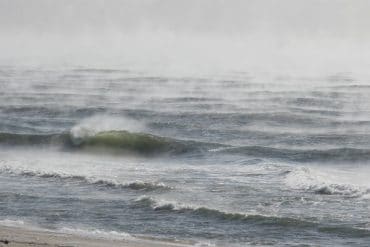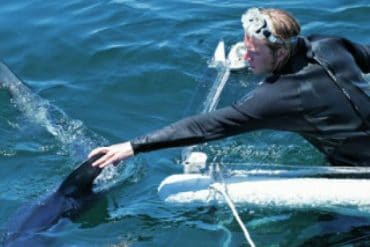Climb aboard one of the hottest sailboats to hit the high seas.
 To the untrained eye, Outlier might appear to be just another pretty sailboat cruising around Nantucket Harbor. But ask just about any knowledgeable sailor and they’ll tell you that this fifty-five-foot yacht is more akin to a spaceship than a watercraft. Packed with more sophisticated electronics and sleek customizations than the Apollo 11 lunar module, Outlier is designed to sail as fast as possible while still adhering to the classic wooden yacht racing tradition. And therein lies the inspiration for its name—Outlier might sail on the same waters as other yachts, but it’s truly in a league of its own.
To the untrained eye, Outlier might appear to be just another pretty sailboat cruising around Nantucket Harbor. But ask just about any knowledgeable sailor and they’ll tell you that this fifty-five-foot yacht is more akin to a spaceship than a watercraft. Packed with more sophisticated electronics and sleek customizations than the Apollo 11 lunar module, Outlier is designed to sail as fast as possible while still adhering to the classic wooden yacht racing tradition. And therein lies the inspiration for its name—Outlier might sail on the same waters as other yachts, but it’s truly in a league of its own.
“There is really no equivalent boat,” says Outlier’s owner Harvey Jones, a Silicon Valley titan and longtime summer resident. Growing up summering on the Jersey Shore, Jones first learned to sail on a Sunfish that he and his father built together from a kit. “I was much more of a surfer than a sailor back then,” Jones says, “but when I arrived on Nantucket [thirty years ago], I bought a sailboat to teach my kids.” From chartering 12 Meters to race in the Opera House Cup in the mid-nineties, Jones eventually purchased Piera, a renowned 1955 sloop with which he won two Opera House Cups.
He continued to expand his fleet from Piera to a W-46 Class yacht named Mustang and to a Nantucket Alerion named Java. “I love wooden boats,” Jones says. “They’re fun to be around, the people who build them are cool and the people who sail them appreciate the aesthetic of wooden boats.”
 But when the Opera House Cup began changing its handicapping rules and the rating system, Jones decided that he wanted to build a boat that would set a new standard in wooden yacht racing. “How do you innovate in this area of wooden boats, to really think outside of the box while still being suited for the new racing rules?” Jones recalls thinking.
But when the Opera House Cup began changing its handicapping rules and the rating system, Jones decided that he wanted to build a boat that would set a new standard in wooden yacht racing. “How do you innovate in this area of wooden boats, to really think outside of the box while still being suited for the new racing rules?” Jones recalls thinking.
“Moreover, the wooden boat industry is going to die out if all it is doing is maintaining old boats, so how do we also innovate a wooden boat so that the industry can still prosper?” So began a year and a half adventure designing and building a boat like no other.
 Outlier was designed by Botin Partners Naval Architecture in Spain. The highly sought-after design team is responsible for some of the most successful professional, high-budget sailing yachts in the world. The racing yachts sketched on their draft boards have gone on to amass an unprecedented string of world championships. So when Jones was looking to build a custom wooden sloop to compete in Nantucket’s Opera House Cup and other classic regattas, enlisting Botin Partners was the equivalent of recruiting the 1992 Olympic Dream Team for a game of pickup basketball. The Botin Partners’ custom design was built in Maine over ten months by Brooklin Boat Yard. “Outlier is an incredible marriage of modern engineering and traditional styling,” said Steve White, the president of Brooklin Boat Yard. “She exemplifies the continuing evolution of the Spirit of Tradition Class. She’ll perform well on the racing circuit while carrying on the classic aesthetic for which wooden boats are well known.”
Outlier was designed by Botin Partners Naval Architecture in Spain. The highly sought-after design team is responsible for some of the most successful professional, high-budget sailing yachts in the world. The racing yachts sketched on their draft boards have gone on to amass an unprecedented string of world championships. So when Jones was looking to build a custom wooden sloop to compete in Nantucket’s Opera House Cup and other classic regattas, enlisting Botin Partners was the equivalent of recruiting the 1992 Olympic Dream Team for a game of pickup basketball. The Botin Partners’ custom design was built in Maine over ten months by Brooklin Boat Yard. “Outlier is an incredible marriage of modern engineering and traditional styling,” said Steve White, the president of Brooklin Boat Yard. “She exemplifies the continuing evolution of the Spirit of Tradition Class. She’ll perform well on the racing circuit while carrying on the classic aesthetic for which wooden boats are well known.”

Every detail is cutting-edge: 3D-printed titanium parts, powerful electronic winches and top-of-the-line navigation software. As for arguably the most critical part of Outlier—her sails— Jones enlisted industry-leader North Sails. A single main sail costs upward of $100,000. Depending on conditions, Outlier carries between seven and ten sails. Part of what makes Outlier such a feat of craftsmanship is this balance between modern engineering and the wooden sailboat tradition.
 While wood is much heavier, costlier and more difficult to work with, Jones wanted to be able to race Outlier in the Opera House Cup and other classic yacht regattas, which have strict rules for entry. If Outlier did not have to adhere to these rigid parameters, designers would have likely employed 100 percent carbon fiber as well as a movable “canting keel” and water ballast tanks.
While wood is much heavier, costlier and more difficult to work with, Jones wanted to be able to race Outlier in the Opera House Cup and other classic yacht regattas, which have strict rules for entry. If Outlier did not have to adhere to these rigid parameters, designers would have likely employed 100 percent carbon fiber as well as a movable “canting keel” and water ballast tanks.
To compensate for the lack of these, Outlier relies on its crew as “moveable ballast.” Of the eighteen people required to race her, ten of those crewmembers are used mostly for ballast. “When I first got on her, I was pretty intimidated,” Jones recalls. “But once we came off the dock and set sail, it took all of fifteen minutes to feel comfortable. But you still have to be humble; the forces involved to move the boat through the water at that speed are incredible.”
 From the moment Outlier hit the water last year, she has been winning races and setting course records. “We hadn’t even sailed the boat more than a few days, let alone raced it, and we won the New York Yacht Club Regatta in the Spirit of Tradition Class,” Jones says. Three months after leaving Brooklin Boat Yard, Outlier returned to Maine to compete in the Eggemoggin Reach Regatta—where she set a course record. With Jones at the helm and his longtime captain Chad Hudnut on deck, Outlier went on to win the Nantucket Regatta. “She sails faster than the wind,” Jones says.
From the moment Outlier hit the water last year, she has been winning races and setting course records. “We hadn’t even sailed the boat more than a few days, let alone raced it, and we won the New York Yacht Club Regatta in the Spirit of Tradition Class,” Jones says. Three months after leaving Brooklin Boat Yard, Outlier returned to Maine to compete in the Eggemoggin Reach Regatta—where she set a course record. With Jones at the helm and his longtime captain Chad Hudnut on deck, Outlier went on to win the Nantucket Regatta. “She sails faster than the wind,” Jones says.
Before the coronavirus threw everyone’s summer plans overboard, Outlier was planning on sailing in the fabled Newport Bermuda Regatta. While she waits for the COVID-19 seas to calm, Outlier will continue to call Nantucket her home port—adding yet another claim to fame for the island’s storied sailing tradition.







